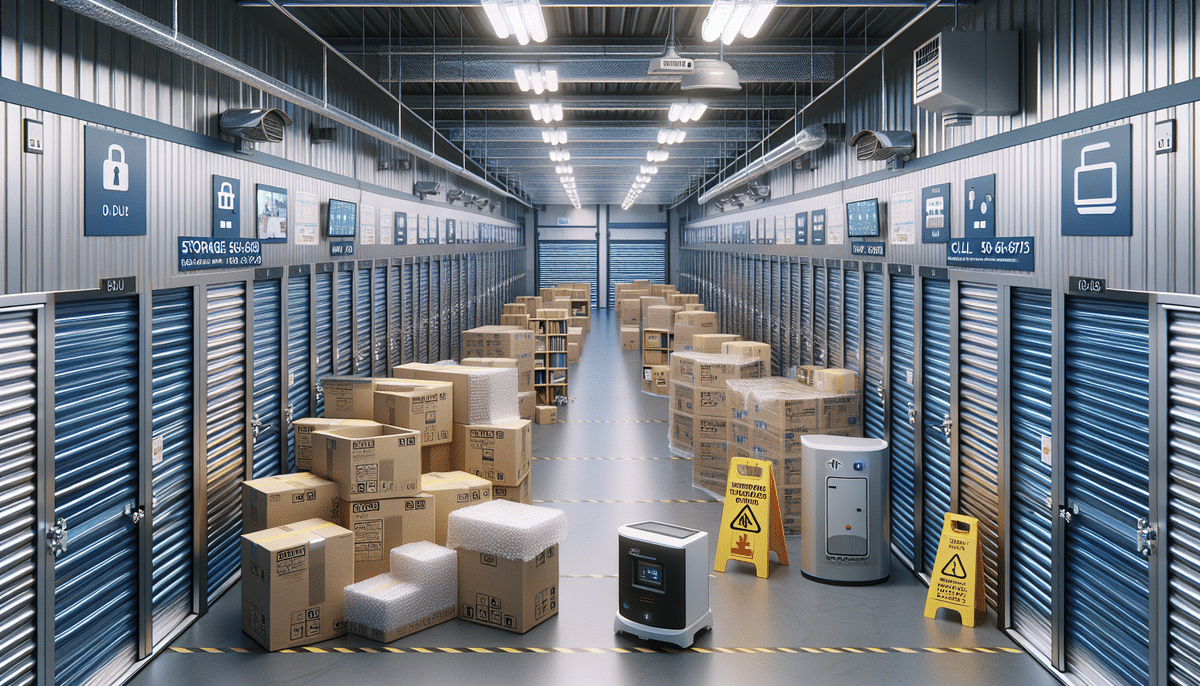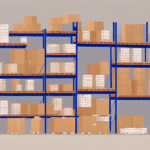Explaining Long-Term Storage: What You Need to Know
If you require long-term storage space, understanding the fundamentals and available options is essential. This comprehensive guide covers everything you need to know about long-term storage, including its importance, factors to consider when selecting a solution, the advantages and disadvantages of various storage types, and much more. Let's delve into the details of long-term storage to help you make informed decisions.
Why is Long-Term Storage Important?
Long-term storage is vital for individuals and businesses that need to store items over extended periods. Whether you're moving to a new home, downsizing, or creating more space, long-term storage offers a safe and secure solution to keep your belongings in excellent condition.
For businesses, long-term storage is beneficial for archiving important documents, equipment, or inventory. Utilizing long-term storage allows businesses to free up valuable office space and ensure items are kept in secure, climate-controlled environments. This protection helps prevent damage or loss caused by natural disasters, theft, or environmental factors.
According to a Statista report, the self-storage industry in the United States generated over $40 billion in revenue in 2022, highlighting the growing reliance on storage solutions for both personal and business needs.
Factors to Consider When Choosing Long-Term Storage Solutions
When selecting a long-term storage solution, several key factors must be considered:
- Storage Unit Size: Assess the volume of items you need to store to determine the appropriate unit size.
- Location and Accessibility: Choose a facility that is conveniently located and provides easy access to your stored items.
- Security Measures: Ensure the facility has robust security features, such as surveillance cameras, gated access, and on-site personnel.
- Climate Control: Opt for climate-controlled units if you plan to store sensitive items like electronics, antiques, or documents.
- Budget: Consider the cost of storage options and available payment plans to find a solution that fits your budget.
Additionally, research the reputation of the storage facility by reading customer reviews and verifying their track record for reliable service. Look for facilities offering special features like 24-hour access or on-site packing supplies to enhance your storage experience.
Pros and Cons of Different Types of Long-Term Storage
Various long-term storage options are available, each with its own set of benefits and drawbacks:
Self-Storage Units
Self-storage units are widely available and offer affordability and ease of access. However, they may lack advanced security features and climate control, making them less suitable for fragile or valuable items.
Portable Storage Units
Portable storage units are delivered to your location, allowing you to pack at your convenience before being transported to the storage facility. They offer convenience and affordability but might not provide insulation or climate control.
Full-Service Storage Solutions
Full-service storage companies handle the entire process, including pick-up and delivery of your items to the storage facility. While they offer convenience and enhanced security, they tend to be more expensive and may not offer 24/7 accessibility.
When choosing a storage type, consider the specific needs of your items and prioritize security, climate control, and accessibility to ensure your belongings are well-protected.
Understanding the Basics of Climate-Controlled Storage
Climate-controlled storage units maintain consistent temperature and humidity levels, typically between 50 to 80 degrees Fahrenheit and 30 to 50 percent humidity. This regulated environment is ideal for preserving items sensitive to temperature and humidity fluctuations, such as electronics, antiques, artwork, and important documents.
One significant advantage of climate-controlled storage is protection against pests and insects. These units are sealed to prevent unwanted intruders from damaging your belongings. Additionally, being located indoors adds an extra layer of security against theft and vandalism.
While climate-controlled storage generally costs more than traditional units, the investment is worthwhile for protecting valuable or sentimental items. When selecting a climate-controlled unit, consider the size, accessibility, and the storage facility's reputation to ensure optimal protection.
For more information on the benefits of climate-controlled storage, refer to the Self Storage Association.
The Role of Humidity Control in Long-Term Storage
Humidity control is critical in long-term storage to prevent damage caused by excessive moisture. High humidity levels can lead to mold, mildew, corrosion, and deterioration of paper products, wood, and fabrics. Utilizing dehumidifiers or climate-controlled storage options helps maintain appropriate humidity levels.
Different items require varying levels of humidity control. For instance, musical instruments and artwork may need more precise humidity regulation compared to clothing or furniture. Research the specific needs of your items and choose a storage solution that accommodates those requirements.
Proper humidity control not only preserves the condition of your items but also maintains their value. Damaged items due to high humidity may lose their value or become unsellable. Investing in effective humidity control measures ensures your belongings remain protected and retain their worth over time.
For detailed guidelines on humidity control, refer to the National Storage Guide.
Tips for Preparing Items for Long-Term Storage
Proper preparation of items before placing them in long-term storage is essential to prevent damage and ensure their longevity:
- Clean and Dry: Ensure all items are clean and thoroughly dried to prevent mold and mildew growth.
- Defrost and Empty Appliances: Appliances should be defrosted and emptied of any perishable items.
- Disassemble Furniture: Where possible, disassemble furniture and cover it to prevent scratches and damage.
- Pack Fragile Items Carefully: Use protective materials like bubble wrap, newspaper, or foam to safeguard fragile items.
- Label Boxes: Clearly label all boxes with their contents and any special handling instructions for easy identification and retrieval.
Consider using climate-controlled storage units for items sensitive to temperature and humidity changes, such as electronics, artwork, and musical instruments. These additional precautions help maintain the condition of your items during storage.
How to Pack Fragile Items for Long-Term Storage
Packing fragile items for long-term storage requires careful consideration to minimize the risk of damage:
- Use Appropriate Packing Materials: Select high-quality packing materials like bubble wrap, packing paper, and sturdy boxes.
- Pack Tightly but Gently: Ensure items are snugly packed to prevent movement, but avoid over-packing, which can increase breakage risks.
- Add Extra Padding: Incorporate additional padding, such as blankets or towels, for added protection.
- Label Clearly: Mark boxes containing fragile items with "Fragile" labels to ensure careful handling.
Choosing a climate-controlled and secure storage unit is also crucial for protecting fragile items from extreme temperatures, humidity, and unauthorized access. Ensure the storage facility has proper surveillance and security measures in place.
Guidelines for Storing Seasonal and Special-Occasion Items
Storing seasonal and special-occasion items, such as decorations, sports equipment, and holiday attire, requires specific strategies to maintain their condition:
- Use Durable Containers: Opt for waterproof and airtight storage containers to protect items from moisture and pests.
- Clean Before Storage: Ensure all clothing and decorations are clean and free from moisture to prevent mildew and mold.
- Label Boxes: Clearly label each box with its contents and the corresponding season or occasion for easy identification.
- Organize Strategically: Group similar items together and store them in an organized manner to facilitate easy access when needed.
Essential Features to Look for in a Long-Term Storage Facility
When selecting a long-term storage facility, prioritize the following essential features to ensure the safety and security of your items:
- 24/7 Security: Look for facilities with round-the-clock security, including surveillance cameras and on-site staff.
- Climate-Controlled Units: Ensure the facility offers climate-controlled storage to protect sensitive items.
- Humidity Control: Facilities with humidity control prevent moisture-related damage.
- Pest Control: Effective pest control measures protect your belongings from insects and rodents.
- Insurance Options: Verify if the facility provides insurance to cover potential damages or losses.
Research and compare different facilities to find one that offers the best combination of security, climate control, and cost-effectiveness to meet your storage needs.
How to Maintain Your Items While in Long-Term Storage
Maintaining your items during long-term storage is crucial to preserve their condition:
- Regular Inspections: Periodically visit the storage unit to inspect items for any signs of damage or moisture buildup.
- Climate Control: Ensure the storage environment remains climate-controlled to protect sensitive items.
- Organization: Keep items organized and accessible to avoid unnecessary handling and potential damage.
Choosing a reputable storage facility with a stable environment and proper security measures contributes significantly to the preservation of your belongings over time.
Common Mistakes to Avoid When Using Long-Term Storage
Avoid the following common mistakes to ensure a smooth long-term storage experience:
- Poor Labeling: Failing to label boxes properly can lead to confusion and difficulty locating items.
- Inadequate Protection: Not using appropriate packing materials can result in damage, especially for fragile items.
- Choosing the Wrong Size: Selecting an improperly sized storage unit can lead to overcrowding or wasted space.
- Neglecting Research: Failing to research storage facilities thoroughly may result in choosing a facility that lacks necessary security or climate control.
By avoiding these mistakes, you can enhance the safety and accessibility of your stored items.
How to Choose the Right Insurance Coverage for Your Stored Items
Insurance coverage is a crucial aspect of long-term storage to protect your belongings against potential risks:
- Facility Insurance: Some storage facilities offer insurance policies that cover damages or losses. Review the terms and coverage limits carefully.
- Home Insurance: Check if your existing home insurance policy covers items in storage. If not, consider adding coverage or purchasing a separate policy.
- Evaluate Item Value: Assess the value of your stored items to determine the appropriate level of coverage needed.
Ensure you understand the coverage provided and any exclusions before selecting an insurance policy. For more detailed information, refer to the Consumer Reports guide on storage insurance.
The Cost of Long-Term Storage: What You Can Expect to Pay
The cost of long-term storage varies based on several factors:
- Unit Size: Larger storage units typically cost more than smaller ones.
- Location: Facilities in urban areas may have higher rates compared to those in rural settings.
- Storage Duration: Longer rental periods may offer discounted rates.
- Additional Features: Climate control, enhanced security, and insurance can increase overall costs.
On average, self-storage unit prices range from $50 to $300 per month, depending on the factors mentioned above. It's advisable to research and compare different storage facilities to find the best value for your budget.
For current pricing trends, consult resources like the Self Storage Association.
Alternatives to Traditional Long-Term Storage Solutions
Alternative long-term storage options include:
- Repurposed Shipping Containers: These offer customizable storage space but may lack climate control and robust security.
- Converted Garage Spaces: Utilizing garage space for storage can be cost-effective but might not provide sufficient protection against environmental factors.
While these alternatives can be more affordable and offer customization, they often do not match the security, climate control, and professional management provided by traditional storage facilities. Assess your specific storage needs and preferences before opting for an alternative solution.
Conclusion
Long-term storage offers a secure and convenient solution for preserving items over extended periods. When selecting a storage option, consider factors such as unit size, location, security, climate control, and cost to ensure your belongings are well-protected. Properly prepare your items by cleaning, packing carefully, and labeling boxes to maintain their condition. Additionally, invest in appropriate insurance coverage to safeguard against potential risks.
By taking these steps and choosing a reputable storage facility, you can ensure your items remain in excellent condition and retain their value during long-term storage.






















